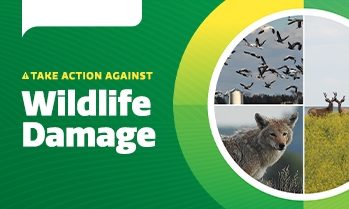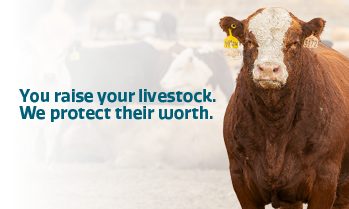Wildlife Damage Prevention
Funding is available to producers for prevention measures taken to limit or reduce the wildlife damage to crops, feed supplies and livestock.
Contact us today to learn ways to prevent wildlife damage.
Call Us Email Us
Crop Damage Prevention
Fencing
Producers can receive funding for steps taken to prevent wildlife damage to feed supplies. Fencing for grain bag storage is not eligible. Funding can be acquired for:
- Fencing around feed yards
- Temporary fencing to protect feed sources
- Fencing to protect nurseries and market gardens
To qualify, you must first contact a customer service office and explain the wildlife problem. An adjuster will visit the farm and make recommendations. If the adjuster recommends establishing a fence around a feed supply, the producer can receive funding to offset the material costs. This funding is based on the current claim and the potential for future damage. Labour costs are not eligible.
Basic fence specifications must be met. There are size/criteria required for each type of operation. Criteria are available from any SCIC office. The customer is responsible for the purchase of fencing supplies.
Fence packages for nurseries and market gardens are unique and producers requiring such should contact a customer service office for more details.
Verification the producer has met the feed protection requirements will have to occur before payment is issued. If a customer refuses a fence as a recommended prevention method, they may be denied future compensation.
SCIC may recommend other measures to protect feed supplies. Those could include:
- Lure crops
- Establishing waterfowl feeding stations
- Intercept feeding for forage
- Scare cannons
Predation Prevention
SCIC can help producers manage their predator attacks through control measures designed to reduce wildlife damage. Examples of predation prevention measure include:
- Fencing effective for specific to livestock/fowl operation
- Fence patrol
- Record keeping/monitoring of livestock or fowl on a daily basis
- Birthing area that is protected versus an exposed area or an area bordering prime wildlife habitat
- Properly trained guardian dogs
- Appropriate dead stock management (for example, dead stock should not be fed to guardian dogs)
- Use of llamas and donkeys as guardian animals
- Paddock/field size suited to the number of guardian animals
- Night confinement close to residence
- Noise, light and other deterrents
A combination of the above methods is often required
Alternative Feeding Systems
In these systems, the feed source is left in the field where managed livestock consume it as a fall/winter feed source. Swath, bale and corn grazing used as part of a well-managed feeding system are eligible for compensation. Well-managed feeding systems are defined as follows:
- There must be fences in place to confine the livestock; the movement of livestock on the feed must be controlled.
- The feed must be suitable for livestock. It must be either baled feed, standing corn or a crop grown with the intention of swath grazing.
- There must be a plan in place to ensure livestock are making full use of feed and there is no excessive waste. The livestock also need to be rotated throughout the field, ensuring the nutrients are returned evenly to the land.
- The livestock must have access to water/snow and shelter/windbreaks.
In the case of alternative feeding systems, evidence is required to show the feed was intended for consumption by livestock.
Predation Specialists
On the recommendation of a SCIC adjuster, a predation specialist can be hired to assess the situation and take steps to eliminate the predator problem. These predation specialists will work with you to determine which measures are suitable for your operation. The producer is expected to implement the measures recommended by the predation specialist. Further predator control services and compensation may be denied if recommendations are not followed.
Guardian Dog Rebate Application form
SCIC can provide up to $400 to help producers offset the cost of purchasing a livestock guardian dog. The use of guardian dogs can be an effective method of preventing predation; however, it does require the commitment from the producer to develop the potential of the dog. Livestock guardian dogs are most effective when complemented by other predation management practices. Producers requesting this funding should contact their local SCIC office to complete this form. Receipt of purchase for the dog and breeder information is required to be eligible for compensation. There is no limit on the number of livestock guardian dogs that may be compensated.
Download Form






